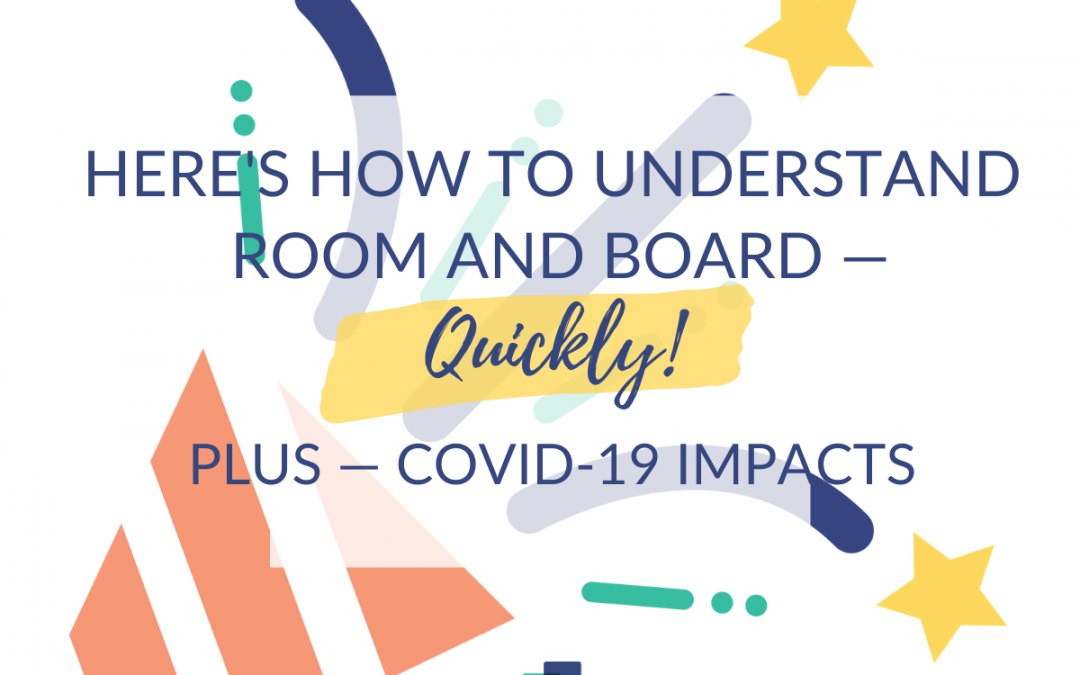When you skim through lists of college costs, your eye often lands on room and board. What
Here are a few quick facts from Urban Institute:
- Almost 60 percent of full-time students enrolled in private nonprofit four-year colleges and universities live in college housing.
- Only 36 percent of public four-year college students live in college housing.
- One-quarter of full-time undergraduate students live at home with their parents.
I remember that families I worked with were often confused about the divisions between room and board
Let’s find out — and put all of it into a COVID-19 context.
Contents
- What is Room and Board?
- Room
- Board
- How Much Does Room and Board Cost?
- Is it Cheaper to Live Off Campus?
- How to Make Room and Board More Affordable
- How to Pay for Room and Board
- Cash
- Scholarships and Outside Scholarships
- Grants
- Student Loans
- Federal Student Loans
- Private Student Loans
- Coronavirus Impact on Room and Board for College
What is Room and Board?
Let’s distill it into its simplest form! It goes back to those basic needs — a place to plop your head on a pillow somewhere that’s clean and dry and a robust meal three times a day (or more).
Room
As I said before, “room” is the price paid for a bed in between those cinder block walls! Colleges typically offer space in a residence hall room for your student and one roommate. However, it’s possible to opt for a single or even a triple room.
On-campus living is sometimes mandatory for students. This can be a great thing because it offers a way to contribute to a robust campus community. Required on-campus living is also an ideal way to adapt to campus life. (It means no waking up at 5 a.m. to make it to the bus stop for an 8 a.m. class or trying to find a parking spot near the science building.) Basic furniture, such as a
Board
“Board” is the amount paid for food at the college of your child’s choice. It usually refers to food and beverages your child can get at on-campus cafeterias. Many schools offer several types of meal plans, which means that while your child won’t have a whole lot of choice over what’s served at school on a daily basis, access to food is definitely ongoing. Fortunately, a lot of cafeterias are buffet style, so that means lots of options at every meal. Dining halls are often super respectful of various dietary needs as well.
College dining halls often do fun things for students, too, such as themed meals and pre-holiday dinners. My alma mater has a tradition called the Breakfast of Champions, in which staff members (including faculty members!) serve students hearty breakfast food at 10 p.m. the night before finals begin. It’s such a great tradition and the whole school shows up.
Many colleges plan to make room and board accommodations for students this year, including required masks, social distancing requirements
How Much Does Room and Board Cost?
Most colleges and universities break down the cost on their website so it looks something like this:
| College or University X | |
| Tuition and Fees | $22,478 |
| Room and Board | $10,010 |
| Books | $1,200 |
| TOTAL | $33,688 |
Room and board costs are different at every school. I’m going to show you some averages from the College Board, but remember, that doesn’t mean that a private nonprofit four-year college will always be more expensive than an
The College Board averages for public two-year institutions in 2019-2020 were:
- $8,990 for public two-year colleges in-district
- $11,510 for public four-year colleges in-state
- $11,510 for public four-year colleges out of state
- $12,990 for private nonprofit four-year colleges
Again, it’s all a matter of doing some research — and keeping track. (Honestly, isn’t that the hardest part — keeping track of all the information you research?) Here’s a visit spreadsheet I created that you can save, rename and keep for yourself to input all the information.
Room and board can seem a lot more expensive than living off campus — or is it? Let’s explore that further in the next section.
Is it Cheaper to Live Off Campus?
In most states, average on-campus housing prices are less than the average rent paid by 18-to-24-year-olds, according to the Urban Institute.
Location also matters. Naturally, urban areas are more expensive to rent in than rural areas. In addition, it may be more expensive to live near a college campus instead of a neighborhood off the beaten path. Here are some common apartment rental fees your child is likely to pay, in addition to utilities like electricity, water, garbage, sewer, internet, cable and more:
- Application fee
- Security deposit
- Pet fee
- Administrative fees
If your child rents with several roommates, living off-campus may be more affordable, especially if your child splits these expenses with roommates. Buying food at the grocery store (while a
The only way to figure it all out is to round up some numbers. Call a few known apartment buildings in the area and find out how much it costs to rent them. Find out what utilities cost
How to Make Room and Board More Affordable
There are most definitely ways to make room and board more affordable — including not messing with room and board at all! Here are some ways to shrink (or eliminate) the costs:
- Learn about all your meal plan options. Your child may be able to get away with
smaller meal plan (like a 14-meal-a-week plan instead of a 20-meal-a-week plan) — especially if a buffet-style breakfast isn’t really your student’s thing. A packet of instant oatmeal every morning may suffice. - Check into more affordable housing options on campus. Many colleges charge exactly the same amount for all residence halls, but others may charge more for apartment-style living or the newest, spiffiest dorm on campus. Ask about comparable costs.
- Choose to have roommates. A single room is usually more expensive than a two- or three-person residence hall room. Is someone from your child’s high school planning to attend that same college? Check with the admission office to find out how to request roommates and to find out how much you’ll save by choosing a double or triple occupancy room.
- Live at home. During COVID-19, your child may not be interested in living in a residence hall room at all. If your home is close to campus, it may be a natural fit for your child to think about living at home and reducing exposure to the virus.
- Live
off campus . Living off campus with roommates can be one way to limit exposure to COVID-19, particularly if some classes are online. Living with just two roommates is a lot different than sharing a bathroom with a whole floor of germy college students.
How to Pay for Room and Board
Here are a few ways you can pay for room and board: out of pocket or through scholarships, grants and student loans.
Cash
Paying for room and board in full is always an acceptable option. Note that you won’t pay a separate amount for just room and board. You’ll pay for all out-of-pocket costs when you get your bill. Learn more about paying for college with a tuition installment plan.
Scholarships and Outside Scholarships
Many outside scholarships — scholarships that aren’t from the institution — cover all qualified expenses, including room and board. On the other hand, some scholarships only cover tuition and fees, books, and course- or degree-related costs (like supplies required for specific classes). They may not cover room and board. Most of the time, however, outside scholarship use is generally left up to how your child wants to use it — unless the scholarship committee works with the college directly.
Something to note: Any scholarship your student uses to pay for tuition, fees and course materials, including required textbooks, supplies and equipment, are tax-free. On the other hand, whatever your child spends on living expenses, such as room and board, is taxable.
Grants
Your child’s college can apply grant money toward tuition, fees, and (if you live on campus) room and board. Any money left over is given back to your child to pay for other expenses.
Student Loans
Student loans can also cover the costs of room and board. Look into student loans carefully and make sure your child understands which options are best. Here’s a quick rundown.
Federal Student Loans
The U.S. Department of Education loans these federal loans to college-bound students:
- Direct Unsubsidized and Subsidized loans
- Direct PLUS loans: This includes Grad PLUS loans for graduate and professional students and Parent PLUS loans for parents of undergraduate students.
Federal student loans are more flexible than private student loans for several reasons:
- No credit checks involved, with the exception of the Direct PLUS loan, which does require a credit check.
- Income-driven repayment plans are an option, which means repayment is based on how much your student makes once he or she graduates from college.
- Repayment plans can change as needed.
- Federal student loan interest rates are lower compared to private loans.
Private Student Loans
A local bank, credit union or national bank are three primary options.
These loans can fill in the need gap after your student has exhausted these options, in order: Scholarships, grants, parent/student savings and federal student loans. Here are some fast facts about private student loans:
- You’ll hear about two types of interest rates: fixed and variable interest rates. Fixed interest rates are just like they sound — they don’t change, so your monthly payments stay the same. Variable interest rates go up and down.
- You or your student can make interest-only or fixed payments while you’re in school.
- Private loans often require a co-signer. This person is commonly you, the parent, or another relative. Students can qualify for a private loan without a co-signer, though that’s difficult to achieve. No matter who applies for the loan, you will need a good credit score and will need to show proof of income.
Ultimately, it’s important to break down all the costs and figure out which room and board coverage options work best for your family.
COVID-19 had a major impact on room and board this past spring. As soon as colleges announced they’d move to online learning, students began asking about cash refunds prorated to the day administrators directed students to move out of residence halls.
If the same thing happens again, online learning could require college and universities to return room and board fees again. It remains to be seen what will happen at this time.

